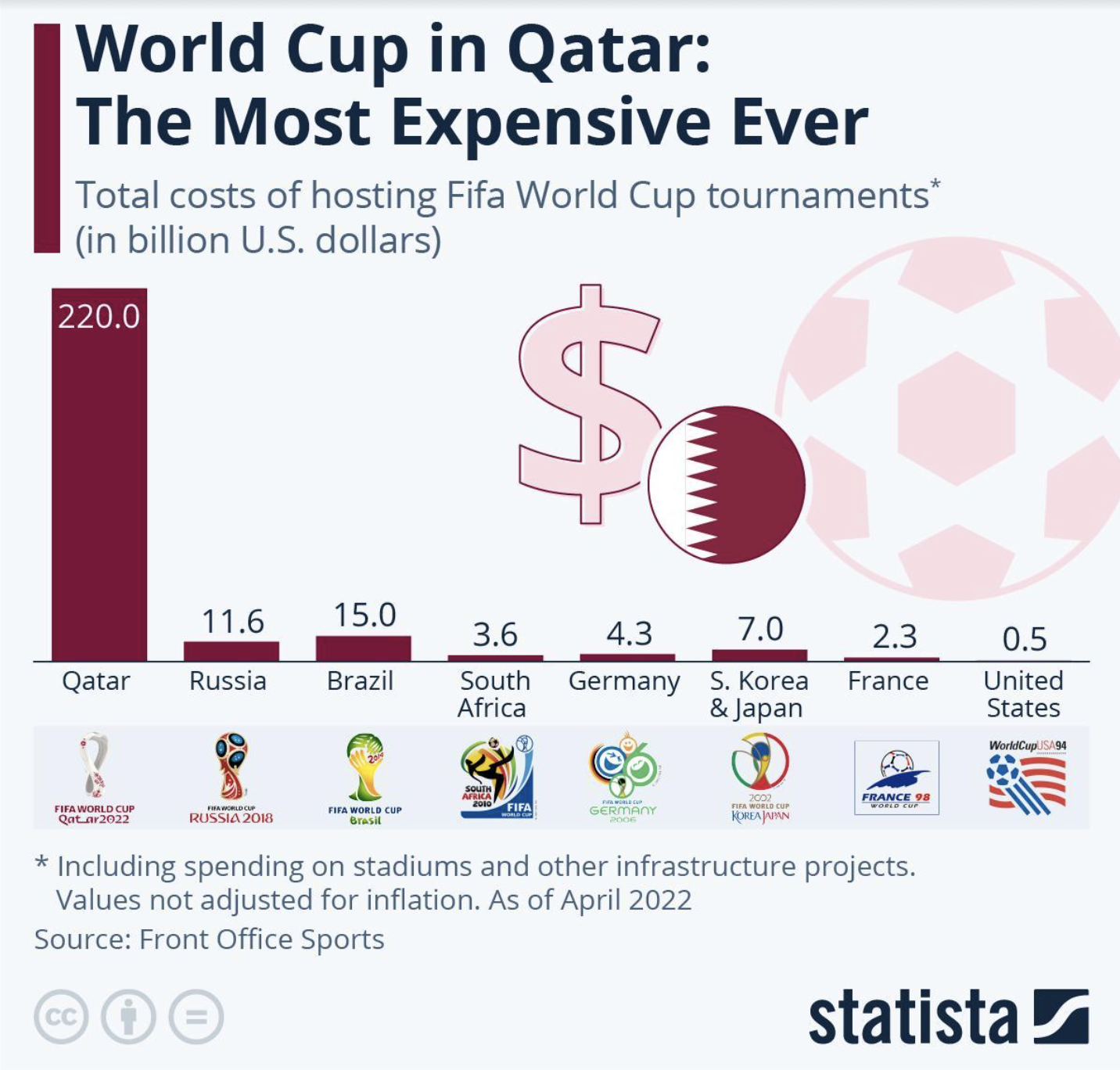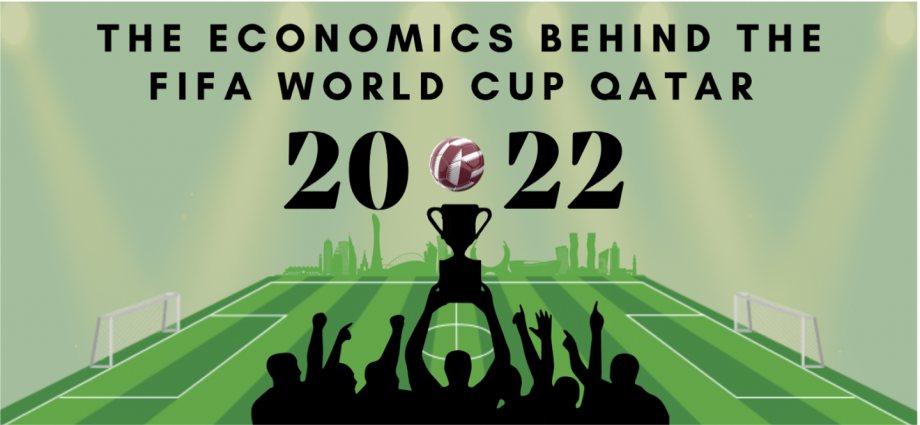Author: Logan Carney, Graphics: Acasia Giannakouros
The BRB Bottomline:
With the FIFA World Cup Qatar 2022TM just around the corner, the quadrennial questions are, once again, swirling around the event. In particular, questions are being raised around its economic practicality in a developing country that had to spend billions of dollars on constructing the required, large-capacity stadiums and corresponding necessities. Will the broadcasting profits and tourism and publicity boost ultimately result in economic profitability for the country, or will Qatar never overcome its initial construction and bribery costs?
With 3.3 billion people tuning into its 2018 broadcast alone, the World Cup is an undoubtedly massive sports tournament, and one that draws attention from all around the world. Unsurprisingly, countless countries desire to be the hosts of a tournament that guarantees billions of broadcast viewers and typically over a million tourists — but not everyone is lucky enough to have the opportunity. The World Cup hosts are determined through a bidding process in which countries (or groups of countries) submit bids (completed template documents that indicate the desire to host, compliance assessment, risk assessment, and technical evaluations that cover infrastructure and commercial components) for hosting rights, and the FIFA Executive Committee votes on who should be selected. In the case of a tie, the FIFA President serves as the deciding vote. In recent years, many committee members, as well as two former presidents, have been at the focus of bribery scandals, with the presidents even being indicted for fraud. As a result of these scandals, much of their corruption has come to light — now, it is widely confirmed that bribery was the driving force behind many developing countries (like Qatar and Brazil) receiving World Cup hosting rights. Moving forward, with the implementation of stricter oversight and safeguarding procedures, this sort of corruption should not be expected to occur again in the future. But, looking back at the countries that bribed their way into the revenue streams that come with mass tourism, was it really worth it? Take Qatar, this year’s host, for example, who had to put substantial investment in constructing over a dozen new, large-capacity stadiums. In return, the publicity from the World Cup has cast a dark shadow over the country’s image, entailing further economic damages. Is the economic boom caused by World Cup tourism enough to justify the trouble and construction costs? Or, would Qatar be better off had it not offered to host this year’s tournament?
Direct Monetary Costs for Qatar
This year’s World Cup is estimated to be the most expensive World Cup of all time. The initial costs for Qatar came before construction on the stadiums even began, as the country had to bribe the FIFA officials to secure the selection of Qatar as a host site. Investigation into the secret bribes found that they totaled a staggering $880 million, with $400 million being offered prior to the selection day, and the rest coming afterwards, once Qatar was confirmed as the 2022 host. Once selected, Qatar began constructing new stadiums that would fulfill the capacity requirements laid out by FIFA, and although their initial proposal estimated the cost at $4 billion, it has since grown to be in the reported range of $6.5 to $10 billion. The infrastructure package in Qatar that included the stadium costs totaled $220 billion, but it does include plans for the country’s broader goals of becoming a global innovation hub by 2030. Qatar envisions itself becoming a technological center for business and has worked on reaching this goal over the past decade as it has shifted towards a digital economy focusing on cloud services and data usage. Luckily, the hotels, airport improvements, and transportation costs included in the infrastructure package will directly aid and are necessary in hosting the World Cup. However, infrastructure construction plans are running behind schedule as Qatar’s little engine struggles to keep up with the enormous scales that a World Cup entails — the country needs to make preparations to host 1.2 million fans, around half of its population. Just two months before the first match of the tournament, some facilities intended to be open during the World Cup are still under construction. The 130,000 promised hotel rooms are supposedly still expected to be ready (although the potential use of tents as alternatives has been prefaced by the media if all of the rooms are not fully constructed by the time the World Cup begins). Included in the infrastructure package and also required for the World Cup, an overhaul of the sewage systems across Qatar has been both costly and time-consuming. The astounding $220 billion cost for this year’s World Cup highlights the strong need for host nations to achieve long-term success as a tourist destination and innovation hub after the event in order to make up for the large up-front costs of hosting.

Direct Revenues from the World Cup
FIFA World Cup host countries receive direct revenues through the sale of tickets and broadcasting rights, as well as the purchases made in the country by visiting teams and fans. The most recent estimates from June value these expected revenues for the 2022 World Cup at $17 billion. Therefore, the country of Qatar is banking on around another $200 billion in expected revenue resulting from the publicity of the tournament. But what happens when publicity turns negative and casts a dark shadow over a host country’s national image?
Poor Publicity and a Bad Image
Because Qatar needed to construct multiple large-capacity stadiums, hotels, a metro system, upgrades to its airports, and many other infrastructure-related projects, the nation brought in around 30,000 foreign laborers. Since the start of construction, 6,500 migrant workers have died due to poor safety regulations in the country, and employers have failed to pay countless migrants their full salary before ordering them home. The government of Qatar did not pass labor law reforms until recently, after the majority of the construction had already taken place; by then, the damage had been done. Furthermore, the bad publicity for Qatar started even before preparations for the tournament began. Human rights organizations around the world have condemned Qatar for its treatment of migrant workers, who have few rights in the country. It was also recently revealed that Qatar will greatly limit foreign media during the World Cup and prevent broadcasters from filming at any accommodation sites, which effectively denies the media the right to interview or capture the treatment of migrant workers, LGBTQ+ members, or any other oppressed group in the country. These stories only represent the negative publicity the country is getting before the tournament starts, and Qatar’s poor image will likely worsen once the tournament begins and the 1.2 million fans flood the country.
Do the Benefits Outweigh the Costs
Although the long-term results will ultimately not be seen until several years following the 2022 World Cup, the short-term financial benefits are certainly outweighed by the costs, as the temporary influx of revenues stemming from World Cup tourism aren’t nearly enough to dig Qatar out of its hole. With a $200 billion deficit to overcome, it will take years to make up for the initial infrastructure costs — granted, they have already been taken into account as part of Qatar’s 2030 target. Economists have found, however, that the World Cup provides little to no gain in real economic growth and tourism for the host countries following the tournament. So then, what are the main benefits of hosting the tournament in Qatar? The hotels, updated sewer systems, and other critical infrastructure pieces will certainly be applicable to the country’s plans of becoming a global innovation and tourism hub going forward, but it is harder to see this being the case for the newly built stadiums. With the top-flight Qatar soccer league, Qatar Stars League, averaging well under a 1,000-person attendance, stadiums with a capacity of 40,000 to 80,000 will provide no utility and most likely become unused money pits — as they are in Brazil, where they sit empty but still require regular upkeep. The nature of soccer makes it challenging to potentially host other tournaments because the vast majority of tournaments and games are held domestically or closer to the big European leagues — unlike other sports like tennis and golf, which switch venues every weekend.
With the financial costs outweighing the revenues in the short and medium terms, the ultimate benefit of hosting the FIFA World Cup as a developing nation like Qatar is to spread its image out into the world, just as other countries in the Gulf Cooperation Council have been doing in recent years. Flushed with cash from oil operations — especially in the past year as a result of the Russia-Ukraine war and supply chain crunches — Qatar can easily take a loss from the enormous costs for the World Cup, just as Saudi Arabia had done in the creation of the LIV Golf Tour. Like the other surrounding, oil-rich countries around it, Qatar is attempting to become a tourist destination and innovation hub over the next decade or two and is using the World Cup as a way to broadcast a positive global image by focusing on the grandeur of fresh, modern buildings and stadiums. However, the unanticipated bad press might prove to hamper the image of Qatar left around the world following the tournament, lengthening the timeline for Qatar to become a tourist destination and thereby extending the timeframe for infrastructure losses by even longer. Therefore, it appears that it is not worth the money for Qatar to host the FIFA World Cup Qatar 2022TM; even though the initial costs for the tournament are no concern for the country, the blood-stained image created by the increased publicity could prove detrimental to Qatar’s short and medium-term goals, making the hosting of the World Cup a waste of time and resources and leaving the fate of the country’s tourism future on the hope of a repaired image and reformed laws.
Take-Home Points
- Qatar bribed FIFA officials for its selection as a FIFA World Cup host country and will host the FIFA World Cup Qatar 2022TM in November.
- Qatar spent $220 billion on infrastructure for its hosting of the World Cup, but this staggering figure also incorporates its 2030 plans of becoming a tourist destination and innovation hub.
- Only receiving an expected $17 billion in revenues from hosting the World Cup, Qatar is banking heavily on the publicity from the tournament influencing the world to desire to travel to the country for both vacation and business.
- Lack of safety regulations and proper oversight by the Qatar government has left 6,500 migrant workers dead and many unpaid for their labor.
- The blood-stained image of Qatar will damage its short and medium goals, making the benefits from the increased publicity for the country, as a result of hosting the World Cup, minimal and much less than anticipated.


I agree that Qatar’s bid to host the Super Bowl was questionable, especially on your point about the stadiums. Was there no other avenue for Qatar to fulfill it’s mission than to construct brand-new, never-to-be-used-again facilities?
bruh said superbowl